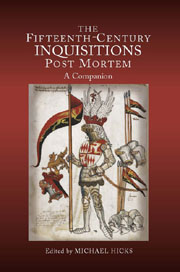Book contents
- Frontmatter
- Contents
- List of Tables and Figures
- List of Contributors
- Preface
- Glossary
- Abbreviations
- 1 Introduction
- 2 Crossing Generations: Dower, Jointure and Courtesy
- 3 The Lesser Landowners and the Inquisitions Post Mortem
- 4 Tales of Idiots, Signifying Something: Evidence of Process in the Inquisitions Post Mortem
- 5 The Value of Fifteenth-Century Inquisitions Post Mortem for Economic and Social History
- 6 ‘Notoriously Unreliable’: The Valuations and Extents
- 7 The Descriptions of Land Found in the Inquisitions Post Mortem and Feet of Fines: A Case Study of Berkshire
- 8 Re-assessing Josiah Russell's Measurements of Late Medieval Mortality using the Inquisitions Post Mortem
- 9 A Great Historical Enterprise: The Public Record Office and the Making of the Calendars of Inquisitions Post Mortem
- 10 Writs and the Inquisitions Post Mortem: How the Crown Managed the System
- 11 ‘Thrifty Men of the Country’? The Jurors and Their Role
- 12 Place-Names and Calendaring Practices
- Index
6 - ‘Notoriously Unreliable’: The Valuations and Extents
Published online by Cambridge University Press: 05 February 2013
- Frontmatter
- Contents
- List of Tables and Figures
- List of Contributors
- Preface
- Glossary
- Abbreviations
- 1 Introduction
- 2 Crossing Generations: Dower, Jointure and Courtesy
- 3 The Lesser Landowners and the Inquisitions Post Mortem
- 4 Tales of Idiots, Signifying Something: Evidence of Process in the Inquisitions Post Mortem
- 5 The Value of Fifteenth-Century Inquisitions Post Mortem for Economic and Social History
- 6 ‘Notoriously Unreliable’: The Valuations and Extents
- 7 The Descriptions of Land Found in the Inquisitions Post Mortem and Feet of Fines: A Case Study of Berkshire
- 8 Re-assessing Josiah Russell's Measurements of Late Medieval Mortality using the Inquisitions Post Mortem
- 9 A Great Historical Enterprise: The Public Record Office and the Making of the Calendars of Inquisitions Post Mortem
- 10 Writs and the Inquisitions Post Mortem: How the Crown Managed the System
- 11 ‘Thrifty Men of the Country’? The Jurors and Their Role
- 12 Place-Names and Calendaring Practices
- Index
Summary
The central purpose of inquisitions post mortem (IPMs) was to enable the king to exploit to the full his feudal rights. Primer seisin and prerogative wardship entitled the crown to occupy the estates of deceased tenants-in-chief and to receive the issues. Valuation of those estates was therefore an essential element of the IPM, enabling the crown to anticipate its future income or, more usually by the fifteenth century, to assess the worth of wardships as a form of patronage. The writ diem clausit extremum ordered the crown's escheator to enquire as to the lands held by a tenant-in-chief, the services by which they were held, and ‘what those lands and tenements are worth yearly in all their issues’. In the inquisitions themselves, such valuations sometimes appeared in summary form – ‘the manor of x is worth y yearly’ – and sometimes in more detail, setting out the annual value of an estate's individual components: the capital messuage (chief dwelling or manor house), arable, pasture, and so on. Historians often refer to the summary entries as ‘valuations’ and the more detailed as ‘extents’, a distinction we shall follow here; although, as we shall see, extents themselves also vary considerably in their level of detail. Both valuations and extents potentially form a key source for historians, the former offering more generalised information about the incomes of landowners, and the latter providing more specific details about how manors were exploited: the proportion of arable and pasture, of free and villein rent, and so on.
- Type
- Chapter
- Information
- The Fifteenth-Century Inquisitions 'Post Mortem'A Companion, pp. 117 - 144Publisher: Boydell & BrewerPrint publication year: 2012



